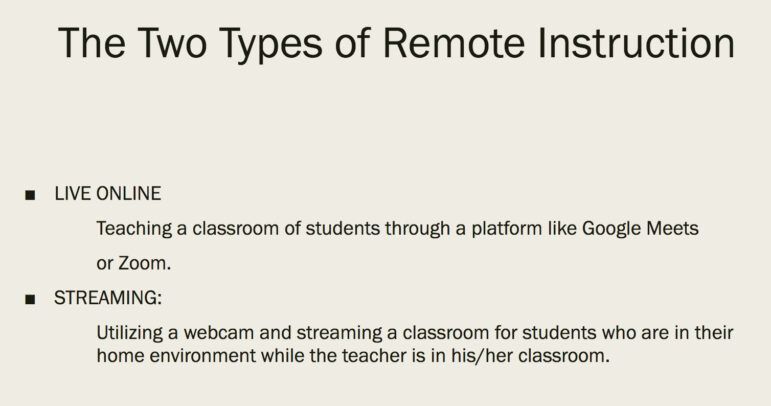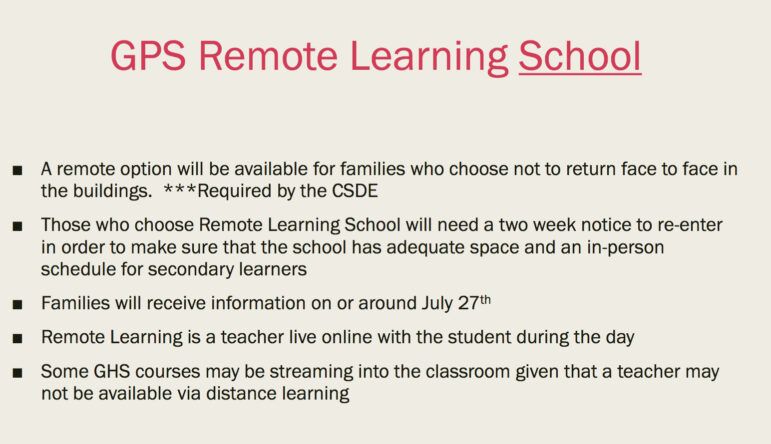In the second of two special Board of Education meeting this week, reopening plans were again discussed.
Since Monday, the State Dept of Education gave districts a waiver of three instructional days to instead use for staff development.
Given the waiver, the first day of school for all students will be September 9, which is unique in that it falls after Labor Day. September 8 will be orientation day.
Also, on October 12 school will be open. In the past schools scheduled professional development on that day, which gave an opportunity for college visits.
During the meeting superintendent Dr. Toni Jones talked about several frequently asked questions, including what happens if someone tests positive for Covid-19.
She said if a student or member of staff tests positive, his or her cohort must leave school to quarantine. Depending on the circumstances – say the student has several siblings – the entire school might have to quarantine for 14 days, which equates to 10 school days.
Board member Meghan Olsson asked if nannies or au pairs were factored into quarantine considerations, and Dr. Jones agreed that was important and the language in the plan will change from “family” to “household.”
She talked about what school will look like in a bit more detail than Monday.
There will be two schools – a live, online teaching school using platforms such as Zoom or Google Meets.

Remote learners in grades K-8 will be assigned to a specific remote learning classroom and grouped with peers on the same grade level. Kids would first be grouped with the children from their own school.
“However class groups may be combined with children from other schools if there aren’t enough to fill a classroom,” Jones explained. “It depends on how many children are opting out.”
She said Special Education may offer some face-to-face services but opt for remote learning for the rest of the day.
“Where we’re looking at the hybrid model with half the students at home, that half can be watching live,” she said, given the preferred model where at GHS group A goes in person to school 2 days. Wednesday would be a deep clean day. Group B goes into the building on Thursday and Friday. She said having all students in school is a requirement of the State Dept of Education.
The live in-person school will use streaming via a webcam from the classroom to the home.

Jones said the district anticipates about 20% of students to opt out of in-person school. She said students would have to wait two weeks if they change their minds and want to return to live face-to-face teaching.
“We want to make sure we have the space and the best classroom for them,” Jones said, adding that around July 27 the district will share details of the plans with all parents.
Marc D’Amico talked about the remote learning experience, noting he had researched districts across the country and examples around the world to seek out best practices, which he said included a 50-50% balance between live teaching and asynchronized (pre-recorded lessons).
He said the curriculum will not change for students enrolled in remote learning, but that the district will create a plan for grading that considers the uneven conditions of remote learning.
Jones said that this fall teachers will take attendance.
“The State didn’t have us taking attendance this spring because it wasn’t in the PSIS (Public School Information System),” she said.

The district is in the process of purchasing laptops for all K-5 teachers so they can teach from home.
Also, D’Amico said there will be opportunities for continual feedback from parents.
“In response to forums we’ve held, we’ve heard it’s important for children to have consistency and structure so we’ll publish clear schedules,” D’Amico said as he shared a slide with a sample elementary school schedule that offered a balance between synchronous and asynchronous instruction.

He said students will see their teacher in the morning and at the end of the day for an activity that enhances their “social emotional learning.”
D’Amico said at any given moment the entire district might have to switch over to remote learning.
“Should we have to, we will call the parents the first night and say we have to pivot to remote learning on day two.” At some point he said a grade, a cohort or a whole school will have to pivot to remote learning for a 14 day quarantine.
“We’re looking at a cohorting model to lower the overall number of students in each homeroom,” he said, adding, “We’re looking at a creative way to keep ALP kids together for a longer period of time and that would include the interdisciplinary period.”
Board member Peter Sherr asked D’Amico when he thought he’d have sample schedules for middle school and high school, noting those schedules are normally extremely complex.
D’Amico said the district was working expeditiously on that and Ralph Mayo and Dana Tulotta should have a draft ready Monday.
Meghan Olsson asked if the town attorney had been consulted about the legality of students appearing in live streaming with an eye to FERPA, which stands for Family Educational Rights and Privacy Act.
Dr. Jones said those conversations are at the state level and education law attorney Tom Mooney is working with the State Dept of Education.
“He is advising us to make sure we’re moving within the law,” she said.
Also, Jones said the district is very comfortable from a legal aspect to having teachers them live stream.
“We are working with GEA and will be discussing it further,” she said. “From a legal standpoint we know we are fine, but we’d like people to be comfortable and on the same page.”
On the topic of the supply of substitute teachers, Jones said it was up in the air.
“We have some subs hired specifically to work within a building. We won’t know until fall if people are feeling comfortable or not,” she said. “If we have teachers who are not well – who need to take leave – we could reach a point that that’s why you go to remote – because we don’t have enough subs to cover the face-to-face classes. We’ll see how many are comfortable coming back in this climate.”
Other frequent questions have concerned ventilation in school facilities.
Jones said ventilation systems have corresponding Minimum Efficiency Reporting Value (MERV) ratings.
“Ours are between 8 and 10, which is the standard,” she said, adding that the facilities director Dan Watson had been studying the topic.
“You can’t just go from an 8 or 10 to a 16. To get to a 13/16 (MERV rating) we could burn our units up, which would not be good.”
Jones said students will be taught outdoors as much as possible, though it might be a challenge to establish social distance and be able to hear the teacher.
This will be more of a challenge at Hamilton Avenue School where the field, which is under re-construction. The field will not be open the entire school year as new grass gets established. The Ham Ave students will have access to the blacktop and climbing area in the fall. There will be scheduled mask breaks outdoors as well.
Given the high enrollment at Eastern Middle School, Jones said parents had asked whether social distancing would be possible. She said EMS has some larger sized classrooms that the other two middle schools don’t, and they will also use elective ares and the media center.
“They’ll capitalize on a lot of spaces you wouldn’t normally use,” she said. “We think we’ll be able to make it work.”
In cafeterias, social distancing requirements have been switched from 3 ft to 6 ft because students will be eating with their masks off. The change is reflected in the updated draft of the reopening plan draft.
Similarly, band and chorus present challenges. Jones said chorus is considered high risk because of singing and projection, and band is similar. “It may have to be more virtual,” she said. “And electives are going to rotate every six or nine weeks to maintain cohorting.”
Cohorts will stay together, but the teachers will swap cohorts.
Jones said the CIAC will govern decisions on fall sports, and they were the body that took the decision to cancel the spring season.
“They are planning on the fall sports season and practice starting around Aug 17,” she said. “It will be a day by day adjustment.”
Some sports involve more contact, including football. Jones said the CIAC is exploring having a season without fans in the stands, and games being live streamed as much as possible.
Jones said parents had been wondering how the district will do assessments to pinpoint gaps in learning from last year. She said the district uses LinkIt to do assessments for K-8.
At Monday’s meeting Jones had talked about transportation and how parents are being asked to drive their children to school to make possible social distancing on school buses.
On Thursday she when the parents drop the students, they are also supposed to wear masks and students riding the buses will be encouraged to keep the bus windows open, which is safer.
As for meal pickup for remote learners, Jones said in the month of June, 25,721 meals were served to Greenwich Schools students, in part thanks to partnerships with United Way, PTAC, Neighbor to Neighbor, Community Centers Incorporated, and Filling in the Blanks. She said families can continue to pick up meals in the parking lot of a school site nearest them. This is the same system that was implemented back in March, when schools closed.
Jones said purchasing additional supplies, PPE and extra staff for the fall will be expensive and the CARES funds of about $850,000 will need to be shared with private schools.
Board member Peter Sherr said his top priority is providing the high quality an education residents are used to, even if students enroll in the remote school – or in the event the entire district has to pivot to remote learning.
He said school start time change hadn’t been implemented properly and he feared implementing remote learning might have similar consequences.
Mr. Sherr, Kathleen Stowe and Joe Kelly all said they were concerned there might be an uptick in enrollment given a number of New Yorkers had bought houses in Town since the pandemic began, and families might be pulling their children out of private schools.
Mr. Kelly said he’d heard there were 10,000 new residents in Greenwich, a Town which typically has a population of about 60,000.
Jones replied that new families can’t walk into to a school to enroll their child, but they can do it online.
She said the enrollment numbers are updated every Monday. “We stay on top of it. Now we are at 98% or 99% of our projection. As a system we’re pretty much on target.”
However, she said, Parkway, Riverside and Old Greenwich Schools are having a grade level spiking and there is a spike in kindergarten in Old Greenwich.
See also:
Greenwich Schools Covid Reopening Plan Starts to Take Shape